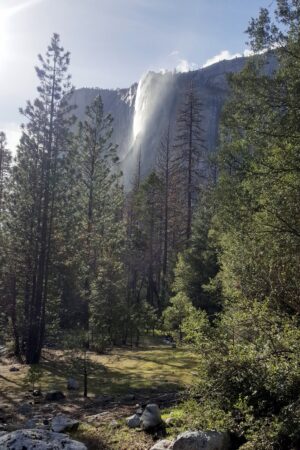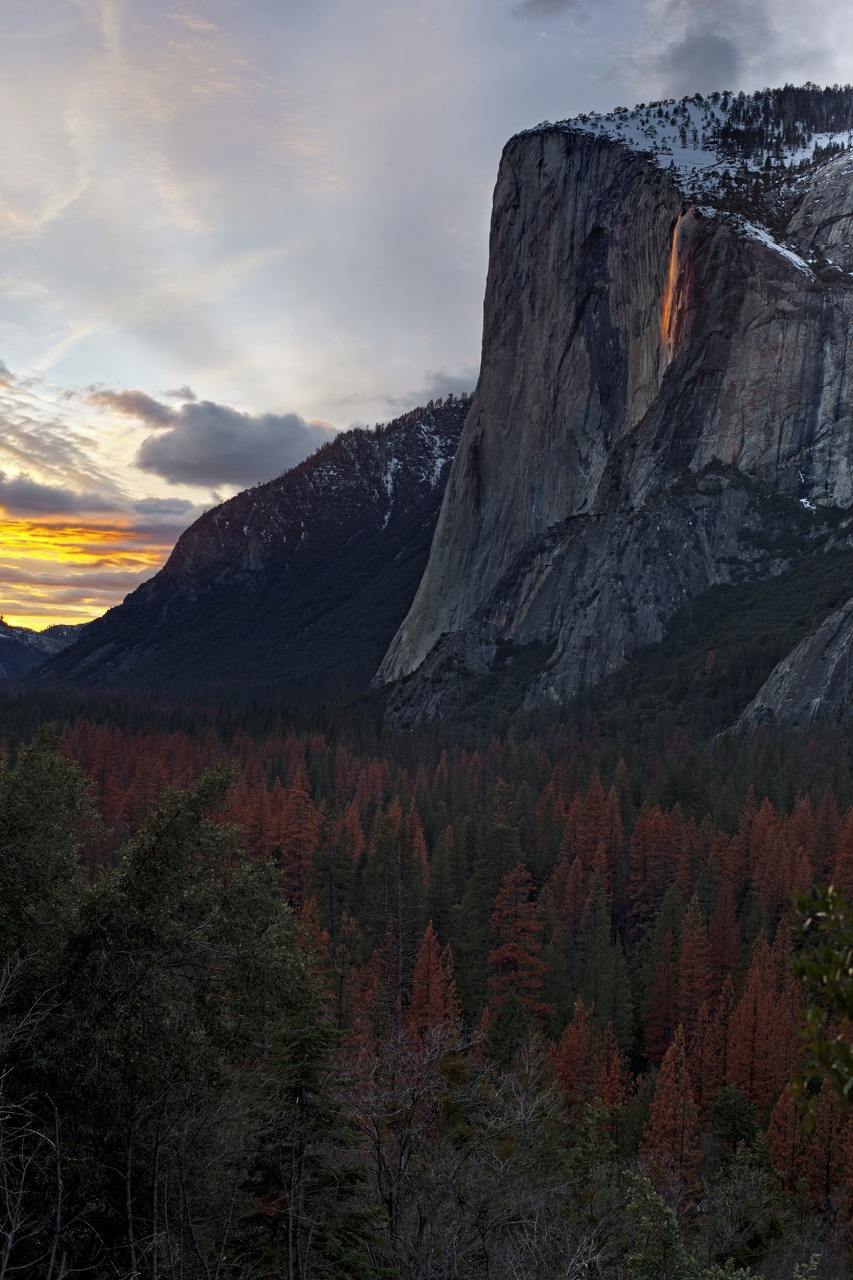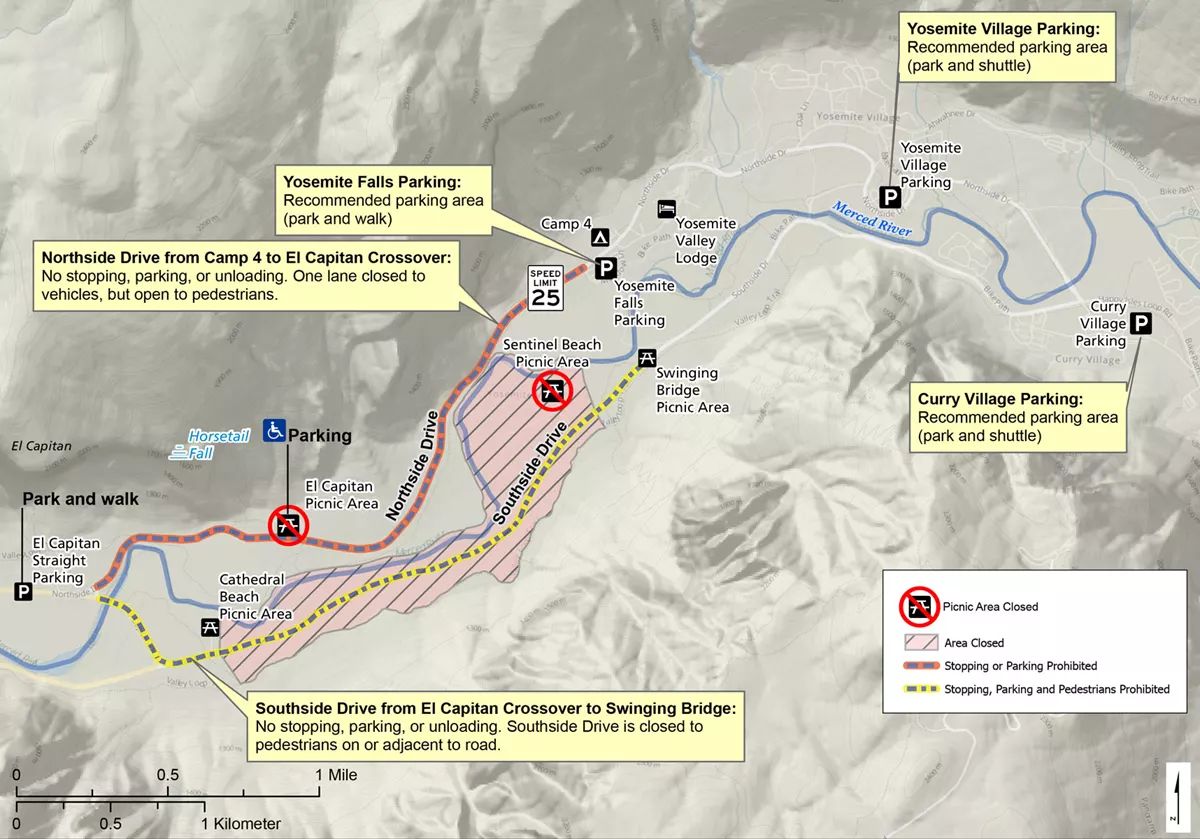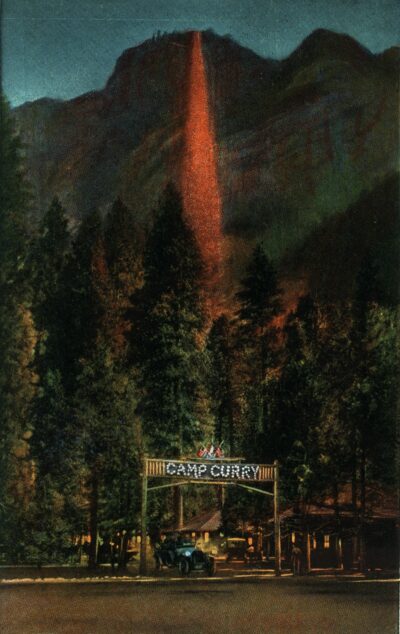The Horsetail Fall event is a natural phenomenon that has grown in popularity in recent years. Horsetail Fall is an ephemeral waterfall that in late winter appears to glow as if on fire when the light hits it and conditions are right.
Here’s what you need to know regarding the park’s reservation requirements, what conditions are needed to see the full “firefall” effect, and the history of the original Yosemite Firefall and the connection to Horsetail Fall.
2024: Reservations are Required: February 10-11, 17-19, 24-25.
During the last three weekends of February 2024 (Saturdays, Sundays, and Monday February 19), Yosemite National Park is requiring every vehicle entering the park to have a reservation through recreation.gov. Reservations are required 24 hours a day on February 10, 11, 17, 18, 19, 24, 25.
How do I get one of these reservations?
There are a variety of reservations that will allow you to enter the park. We will explain how to get day-use reservations, campground, and lodging reservations. Those entering the park on a YARTS bus or with an authorized tour group do NOT require a reservation.
DAY USE RESERVATIONS: If you are not staying inside the park and want to drive your personal vehicle in on February 10, 11, 17, 18, 19, 24, 25, you will need a ‘Horsetail Fall Ticketed Entry’ or day-use reservation from recreation.gov.
There will be two waves of opportunity to create a day-use reservation to the Horsetail Fall event.
Opportunity #1: 50% of the reservations will go on sale December 1, 2023 at 8 a.m. Pacific Time for all arrival dates (February 10, 11, 17, 18, 19, 24, 25).
Opportunity #2: The other 50% of the available reservations will go on sale at 8 a.m. two days in advance. For example at 8 a.m. on February 8, the remaining reservations will become available for February 10. On February 9, the remaining reservations become available for the 11, and so forth.

Mist on Horsetail Fall blowing in the breeze on a spring day. Photo by Yosemite Conservancy/Gretchen Roecker.
Historically reservations have sold very quickly. Pro tips:
- Create a recreation.gov profile beforehand.
- Have everything set up and ready to go the morning of, including your payment information. Each day use reservation costs $2.
- Be logged on to recreation.gov and begin to refresh the page at 8 a.m.
- Make sure the name on the reservation will match the name of a person in the vehicle when you enter the park. You will need to show an ID that matches the name on the reservation to enter.
Other important caveats:
- Each reservation permits ONE vehicle to enter the park. You can have as many or as few individuals in your vehicle with you as you’d like (following all traffic laws, of course). If your group needs two vehicles, each vehicle will need its own reservation and its own reservation holder.
- Each reservation is good for seven consecutive days. You do not need to arrive on the first day of your reservation. For example, a reservation for Sunday, February 11, means your vehicle pass is valid through Saturday, February 17.
- The park entrance fee must be paid in addition to the reservation fee ($2). Having a park pass does NOT equal having a reservation. Passes cover the entry fee for the park, but not your reservation fee. Accepted park passes include the Yosemite National Park Annual Pass, Interagency Annual Pass, Interagency Senior Pass, Interagency Access Pass, Interagency Volunteer Pass, Interagency Military Pass, Interagency 4th Grade Pass, Veteran’s Military Pass, Gold Star Military Pass, Golden Age, and Golden Access.
- More questions? Read Yosemite National Park’s FAQ.
Campground and Lodging Reservations: You do NOT need a day-use reservation if you have campground or lodging reservations INSIDE Yosemite National Park.
- Campground reservations: Upper Pines, Wawona, Hodgdon Meadow, or Camp 4
- Reservations will be released on December 15, 2023 at 7 am Pacific time at Recreation.gov.
- Lodging reservations: Yosemite Valley Lodge or Curry Village
- Private lodging or vacation rental reservation in Wawona, Yosemite West, or Foresta
- Please note that there are many campgrounds, hotels, lodges, and vacation rentals just OUTSIDE the park boundary and those reservations will NOT grant you park entry.
Commercial Use Authorization and the YARTS bus: If you have a reservation for Yosemite Area Regional Transporation System (YARTS) or with an authorized tour group, you do not need an additional reservation or permit.
Do you have additional questions about trip planning for Horsetail Fall 2024? Check out Yosemite National Park’s FAQ page for more details.
What is the Horsetail Fall event?

Horsetail Fall aglow in February 2017. @damoncorso
Horsetail Fall is an ephemeral waterfall that falls over an eastern ridge of El Capitan in Yosemite National Park. It typically only flows in the winter months.
In February, there is a period of time when (if) conditions perfectly align at sunset, the waterfall is illuminated in such a way that is appears to radiate its own light.
There are a certain number of atmospheric conditions that are required for the “flow to glow,” including:
- Horsetail Fall must be flowing. If it’s a particularly cold year or dry year, there may not be any water on the waterfall. No ephemeral waterfall can be trusted. Just ask visitors in August how they feel about Yosemite Falls.
- The sky must be clear. If there is any haze or cloud cover, the glow will be either greatly diminished or non-existent.
- Even when the conditions align perfectly, the actual glow in the flow of Horsetail Fall occurs for a short window of time during sunset. And then the sun will have set and it will be both colder and darker than it was moments before.
- AND on top of all that, please note that many photos that are circulated online have been digitally enhanced.
Now that you know there is a good chance your Horsetail Fall event will probably not be as radiant as your dreams, if you’re still committed to seeing it for yourself, here are some tips to set you up for success:
- Know before you go: Make sure you have all the necessary reservations (see above) and that you know about restrictions during the event (see below).
- When you are in the park: Please listen to all park staff and volunteers. They are there to make sure everyone stays safe and protect park resources, such as sensitive meadow vegetation.
- If you do need help in the park, stop by our Conservancy volunteer crew’s blue information booth, located in the Yosemite Falls Day-Use Parking Lot from February 9 to 28. They are there to provide you with the most up-to-date information.
- Check the Yosemite Valley weather forecast for snow and clouds.
- Dress in warm layers and maybe pack a warm beverage and a few snacks. In order to have a good view of the fall, you’ll likely need to hike a few miles out to a viewing area. Being appropriately prepared for the cold will help keep morale up.
- (a) Give yourself ample time to hike the approximately 1.5 miles (3.2 km) out to the viewing area. It’s not fun to race the sun. Please stay on the trail/designated pathway (aka on the road when you see signage) when walking to the viewing areas. And there are apt to be crowds of people so it could take a moment upon arrival to find a good spot for viewing the fall. Many people will hike out in the afternoon, hours before sunset, to set up.
(b) Give yourself ample time to ride the Yosemite Valleywide Shuttle. These shuttles will most likely be very full during this event, so having extra time to wait for a bus with space would be smart. Shuttles are handicap accessible and will be making their regular stops at the El Capitan Picnic Area. - Vault toilets, along with trash and recycling dumpsters, are available at the El Capitan Picnic Area. Be sure to pack in and pack out any trash from the viewing area.
- Pack a headlamp or flashlight for your return trip. Getting to the viewing area is only half the fun, you still need to hike back — after sunset.

Horsetail Fall event map. Courtesy of NPS
Important things to keep in mind:
- As this annual natural phenomenon event has gained in popularity, it has had big impacts on the vegetation and wildlife in the area. Please follow directions to minimize erosion to river banks and destruction to meadows.
- Bringing a chair can greatly improve your comfort during the viewing period. Please set up any chairs or tripods in previously disturbed areas. If you’re not sure where is a good spot, please ask park staff or volunteers for assistance.
- On the topic on beverages and snacks, please plan ahead and prepare to leave no trace. Packing in and packing out trash from the viewing area helps greatly with minimizing the impact on wildlife. Take note of where restrooms are and are not available.
- When finding your spot please be aware of the impact that crowding can have on these natural spaces, especially along river banks and in meadows.
For more tips and tricks, check out this video from the Yosemite Mariposa County Tourism Bureau.
What else is there to do in Yosemite in February?
- Yosemite Village stays open year-round. The Yosemite Museum, Ansel Adams Gallery, and Yosemite Exploration Center are great places to learn more about the natural and cultural history of Yosemite National Park – while staying warm inside!
- On good snow years, Yosemite Hospitality runs Badger Pass Ski Area. This historic ski area was almost the site of the Winter Olympics. Learn more about Yosemite’s Alternate Histories.
- Check out the Conservancy’s Yosemite in Winter blog for more information on activities (indoor and outdoor) and other winter travel tips.
The History of the Horsetail Fall event
Park rangers and officials will never refer to the Horsetail Fall event as the Yosemite Firefall, though this is the name that most other websites and YouTube videos will use. All of the park’s messaging (and ours) refers to this event as the Horsetail Fall event or the Horsetail Fall phenomenon.

Detail from a historic postcard depicting the historic Yosemite Firefall from Curry Village. Image of YOSE 079431 courtesy of NPS.
The Original Yosemite Firefall
Yosemite National Park saves the word Firefall specifically for the historic event which occurred from approximately 1872 to 1968, where embers from a bonfire were pushed over Glacier Point. In its heyday there was a ritualized routine to the event where spectators would gather in the Valley meadows to behold. Every summer evening there would be a call and response:
“Hello Glacier Point!”
“Hello Camp Curry!”
“Is the fire ready?”
“The fire is ready!”
“Let the fire fall!”
Read more about the human-created spectacle in this Backpacker article: The Original Yosemite Firefall Was a Bonfire Pushed Off a Cliff by Adam Roy.
The Origins of Today’s Fiery Phenomenon
According to an article from the Ansel Adams Gallery: “Even before its fame, the waterfall drew the attention of Ansel Adams, who photographed it in his traditional palette of grays around 1959. But for the most part, it flowed with anonymity while casual observers passed it by; that is until a young climber and photographer named Galen Rowell changed the course of history.”
The current Horsetail Fall event was originally captured on color film by a young climber named Galen Rowell in 1973. The Ansel Adams Gallery retells the story behind the image “Horsetail Fall by Galen Rowell.”
Thanks to the internet and social media, the Horsetail Fall event has grown to attract thousands of people annually in search of this contemporary, au natural, phenomenon.
According to Yosemite National Park, “This event attracts many visitors to a small area, causing traffic congestion, parking issues, safety concerns, and impacts to natural and cultural resources.” By enacting the reservation system during the weekends in February, they are hoping to mitigate some of the safety concerns and impacts to the park’s resources.
As crowds have grown during the day in recent years, some photographers are getting creative with their approach. With the rise in popularity in astrophotography, some photographers have succeeded in capturing the Horsetail Fall illumination by moonlight.
Horsetail Fall at Sunset by Conlon Creatives.
